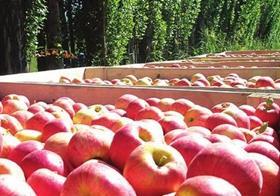
Australian apple growers are continuing to rail against New Zealand imports despite their government effectively opening the door to fruit from that country with the release of an import risk analysis (IRA) document on Wednesday.
In a press release Pipfruit New Zealand CEO Peter Beaven hailed the document release as an end to the industry’s “90-year battle” to have access to the Australian market reinstated.
Australia closed its borders to apples from the country in 1919 after the disease fire blight was found in orchards there.
“Mature symptomless apples do not pose a risk to the Australian industry and that has at last been accepted be the Australian Governments and officials,” said Mr Beaven.
The main protocols New Zealand growers and exporters will have to comply with when exporting to Australia involve the auditing by Biosecurity Australia of all packhouses intending to export fruit across the Tasman. Growers will also have to prove all orchard measures have been adopted to control diseases and pests of concern. Apples will have to be screened to ensure they are mature and symptomless and undergo a standard 600 fruit inspection for actionable pests. High-pressure water washers must also be used and the industry must adhere to appropriate sanitation standards in waterdumps in packhouses.
Mr Beaven said currently four New Zealand packhouses – all situated in the Hawkes Bay - have been audited and qualify to send fruit to Australia. “I expect the first New Zealand apples to be available in Australia soon,” said Mr Beaven.
According to a report by Radio New Zealand, the country’s largest apple exporter ENZA has announced it intends to send several containers of Jazz apples to Australia in the coming months.
ENZA general manager Snow Hardy told the news source the company has apples already cleared for export.
He added that Jazz apples are currently grown in Australia and ENZA would limit the volumes it sends there so as not to affect the local trade.
How New Zealand goes about its exports has become a bone of contention in the industry there, however.
A majority of growers want legislation passed that would see all exports carried out under the auspices of the Horticultural Exporters Association.
On the other side of the fence, however, a smaller group has argued exports should be free of government regulations.
There is a very real fear that if New Zealand dumps too much produce on the Australian market it will cause a glut and push down prices for growers on both sides of the Tasman.
Meanwhile, in Australia growers are continuing to oppose the ruling and have mounted a campaign to promote apples grown in the country.
Apple and Pear Australia Ltd’s (APAL) newly appointed chairman, John Lawrenson, has argued the quarantine measures laid out in the IRA are insufficient.
“The measures adopted in the final policy and determination for the importation of New Zealand apples are horrendously weak and we are extremely concerned that the three pests recognised as major risks to our biosecurity won’t be controlled to the degree the industry requires,” he said.
“Frankly, once New Zealand apples start coming into Australia, farmers will be nervous just getting out of bed in the morning because they will be wondering if today is the day they discover fire blight in their orchard,” he added.
In response to the impending arrival of New Zealand apples Australian growers are branding fruit with ‘Aussie Apples’ stickers, and say they will monitor retailers to ensure the country of origin of apples is displayed.






No comments yet